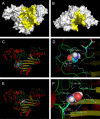Effects of acrylamide on the activity and structure of human brain creatine kinase
- PMID: 20057941
- PMCID: PMC2790104
- DOI: 10.3390/ijms10104210
Effects of acrylamide on the activity and structure of human brain creatine kinase
Abstract
Acrylamide is widely used worldwide in industry and it can also be produced by the cooking and processing of foods. It is harmful to human beings, and human brain CK (HBCK) has been proposed to be one of the important targets of acrylamide. In this research, we studied the effects of acrylamide on HBCK activity, structure and the potential binding sites. Compared to CKs from rabbit, HBCK was fully inactivated at several-fold lower concentrations of acrylamide, and exhibited distinct properties upon acrylamide-induced inactivation and structural changes. The binding sites of acrylamide were located at the cleft between the N- and C-terminal domains of CK, and Glu232 was one of the key binding residues. The effects of acrylamide on CK were proposed to be isoenzyme- and species-specific, and the underlying molecular mechanisms were discussed.
Keywords: acrylamide; docking simulation; human brain creatine kinase; inactivation.
Figures






Similar articles
-
The effects of acrylamide on brain creatine kinase: inhibition kinetics and computational docking simulation.Int J Biol Macromol. 2009 Mar 1;44(2):128-32. doi: 10.1016/j.ijbiomac.2008.11.003. Epub 2008 Nov 18. Int J Biol Macromol. 2009. PMID: 19061912
-
Hydrogen peroxide targets the cysteine at the active site and irreversibly inactivates creatine kinase.Int J Biol Macromol. 2011 Dec 1;49(5):910-6. doi: 10.1016/j.ijbiomac.2011.08.005. Epub 2011 Aug 11. Int J Biol Macromol. 2011. PMID: 21854802
-
The effect of Zn(2+) on human brain creatine kinase: unfolding and aggregation studies.J Biomol Struct Dyn. 2009 Apr;26(5):567-74. doi: 10.1080/07391102.2009.10507272. J Biomol Struct Dyn. 2009. PMID: 19236107
-
Cellular compartmentation of energy metabolism: creatine kinase microcompartments and recruitment of B-type creatine kinase to specific subcellular sites.Amino Acids. 2016 Aug;48(8):1751-74. doi: 10.1007/s00726-016-2267-3. Epub 2016 Jun 18. Amino Acids. 2016. PMID: 27318991 Review.
-
Overview on mitigation of acrylamide in starchy fried and baked foods.J Sci Food Agric. 2018 Sep;98(12):4385-4394. doi: 10.1002/jsfa.9013. Epub 2018 May 11. J Sci Food Agric. 2018. PMID: 29572830 Review.
Cited by
-
Molecular determinants of acrylamide neurotoxicity through covalent docking.Front Pharmacol. 2023 Mar 2;14:1125871. doi: 10.3389/fphar.2023.1125871. eCollection 2023. Front Pharmacol. 2023. PMID: 36937867 Free PMC article.
-
Lack of adverse health effects following 30-weeks of dietary exposure to acrylamide at low doses in male F344 rats.Toxicol Rep. 2016 Aug 31;3:673-678. doi: 10.1016/j.toxrep.2016.08.010. eCollection 2016. Toxicol Rep. 2016. PMID: 28959591 Free PMC article.
-
Development of a Xanthan Gum Based Superabsorbent and Water Retaining Composites for Agricultural and Forestry Applications.Molecules. 2023 Feb 18;28(4):1952. doi: 10.3390/molecules28041952. Molecules. 2023. PMID: 36838941 Free PMC article.
-
Effect of Different Cellulose Fillers on the Properties of Xanthan-Based Composites for Soil Conditioning Applications.Materials (Basel). 2023 Nov 23;16(23):7285. doi: 10.3390/ma16237285. Materials (Basel). 2023. PMID: 38068029 Free PMC article.
References
-
- Friedman M. Chemistry, biochemistry, and safety of acrylamide. A review. J. Agric. Food Chem. 2003;51:4504–4526. - PubMed
-
- Rydberg P, Eriksson S, Tareke E, Karlsson P, Ehrenberg L, Tornqvist M. Factors that influence the acrylamide content of heated foods. Adv. Exp. Med. Biol. 2005;561:317–328. - PubMed
-
- Tornqvist M. Acrylamide in food: The discovery and its implications: A historical perspective. Adv. Exp. Med. Biol. 2005;561:1–19. - PubMed
-
- Blank I. Current status of acrylamide research in food: Measurement, safety assessment, and formation. Ann. N. Y. Acad. Sci. 2005;1043:30–40. - PubMed
-
- Smith EA, Oehme FW. Acrylamide and polyacrylamide: A review of production, use, environmental fate and neurotoxicity. Rev. Environ. Health. 1991;9:215–228. - PubMed
Publication types
MeSH terms
Substances
LinkOut - more resources
Full Text Sources
Research Materials

